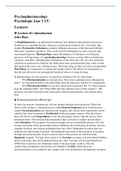College aantekeningen
Volledige Psychopharmacology UU College Aantekeningen
In dit document worden alle hoorcolleges van de cursus Psychopharmacology aan de UU besproken met verdiepende figuren en voorbeelden om je goed voor te bereiden op het tentamen.
[Meer zien]





